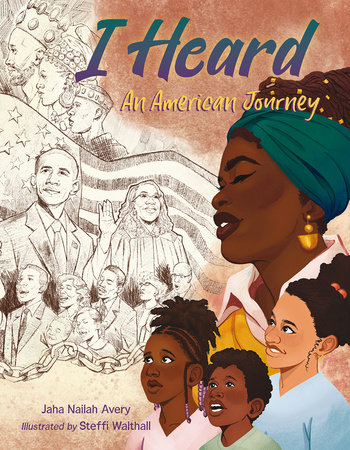A powerful and poetic picture book about Black history in the United States, from the shores of Africa and slavery, to the civil rights and Black Lives Matter movements.With stunning lyricism reminiscent of traditional African spirituals and today's rhythm and flow of hip-hop, a teacher shares the history of being Black in the US, while continuing to march into present day--undeterred and proud to be Black. Author Jaha Nailah Avery shows you have to understand the past to shape the future, and knowing who you are gives you the strength to do just that.
The book's back matter on Black history is an extensive resource and provides additional context to the reading of
I Heard.
Jaha Nailah Avery is an African American woman and proud Southerner. Hailing from Asheville, North Carolina, she received her law degree from the University of North Carolina at Chapel Hill, where she studied constitutional and civil rights law. She spent several years in the startup tech space before embarking on her professional writing career, and her work can be found in the
New York Times,
Rolling Stone, and
Architectural Digest. Her aim is to always document, celebrate, and preserve the stories of Black people, communities, and history.
Steffi Walthall is a VA-based illustrator, a sometimes comic artist and all times storyteller that celebrates diversity in all forms. She loves working on character-centric stories whether they are fictional or historical. www.steffiwalthallart.com
A lesson about the pride and perseverance that inform African American identity.
An adult invites a group of Black children—diverse in terms of skin tone and hairstyle—to gather around and listen. The story begins with Mother Africa and extends into a rich tapestry of ancestry, adversity, and accomplishments. With vibrant imagery and punchy rhyming verse, the book tells readers of African royalty and warriors, trans-Atlantic enslavement, the bravery of those who worked toward liberation, and community organizing and hard-fought institutional change. Contemporary figures appear: President Barack Obama, voting rights activist Stacey Abrams, and Supreme Court Justice Ketanji Brown Jackson. Avery writes in broad strokes about the “countless demonstrations…displayed throughout the nation” but also gets specific about Civil Rights activism, with references to the Student Nonviolent Coordinating Committee and the Divine Nine consortium of Black fraternities and sororities. The result is an accessible work that offers readers much to reflect upon while presenting aspects of African American history and culture that may be new to young readers—and that may prompt further research. An author’s note and appended information on topics and key terms provide a poignant starting point for that research.
Before enslavement and beyond the Civil Rights Movement, African American culture presented in full color and powerful rhyme.
—
Kirkus ReviewsThis sweeping, powerful rhymed historical panorama is delivered, in Walthall’s mix of colored and monochrome scenes, as an artless but passionate poem declaimed to an audience of modern, young mural painters, beginning in an idealized Africa—“I heard the people, Black and free, / community abounds, / thus living all in harmony / with sky, with sea, with ground”—but quickly taking a tragic turn to the Middle Passage, and then speeding past “Moses,” Reconstruction, and “strange fruit” (the nooses in the picture are empty, but crosses burn in the background), to “HBCU football games, / and D9 org formation.” From there, it’s on to sit-ins and “Panthers standing proud,” Black Lives Matter, the rise of a Black president and the fall of a “gentle giant” (George Floyd), and finally a new presence on the Supreme Court: “Black and brilliant, wise and short. / They call her JUSTICE Jackson.” So keep marching, the author urges, and “be proud to be Black!” An unusually concentrated summary of the struggle, as replete with discussion topics as it is with allusions to horrors and highlights.
—
Booklist
Avery masterfully captures the rhythm of African storytelling by weaving a poetic tale of African American history from its roots in Africa through modern times. Told in rhyming couplets, Avery’s story highlights the proud accomplishments of her people, as well as many prejudiced actions taken against them. The Freedom Train of the Underground Railroad, the Reconstruction era following the Civil War, and heroes including President Barack Obama, Georgia State Representative Stacey Abrams, the “Freedom Riders and the N-A-A-C-P,” and Associate Justice of the Supreme Court of the United States Ketanji Brown Jackson counter the heinous actions of slavery, unfair treatment of “Black men who enlisted to bravely fight across the shores, though here no rights existed,” and “crosses set ablaze.” Walthall’s crisp pencil sketches and colorful illustrations, a glossary of terms and civil rights activists, and an author’s note elevate this work’s instructional impact.
—School Library Journal

















